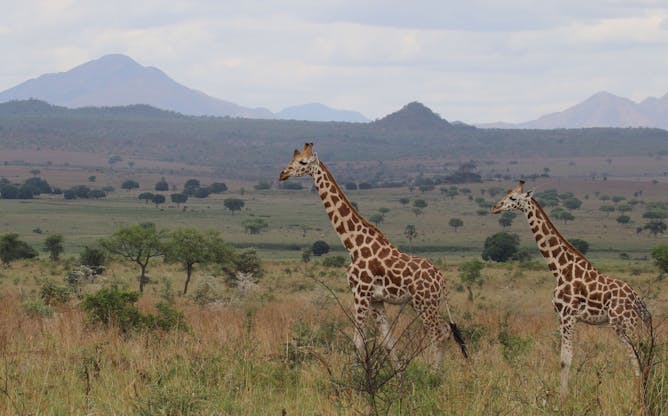|
|
|
|
Happy Sunday − and welcome to the best of The Conversation. First, here are a couple of our recently published stories:
One of the pleasures of reading The Conversation is learning something new and often surprising. For example, while I was always impressed by the graceful and noble giraffe, I didn’t know the average one roamed over 140 square miles – nearly the size of Philadelphia. Some range as widely as 1,500 square miles. Those are two of the facts I learned while reading Michael Brown’s recent piece, which was edited by senior environment and cities editor Jennifer Weeks. Brown, a conservation ecologist, and his team tracked 148 giraffes from all four species to better understand how they can coexist with humans.
Another thing I wasn’t previously aware of came from Middlebury College American studies professor William Nash. His article on country music, edited by technology editor and musician Eric Smalley, explores songs about reproductive rights and how the genre has a surprisingly liberal lineage despite stereotypes of it being inherently conservative.
|

|
Bryan Keogh
Managing Editor
|
|
Readers' picks
|

An average giraffe has a home range almost as large as Philadelphia.
Michael Brown
Michael Brown, Smithsonian Institution
The largest ever giraffe tracking study shows how these massive animals are responding to human pressures across many different habitats throughout Africa.
|
|
|
-
Raymond Scheppach, University of Virginia
A former executive director of the National Governors Association explains what it is about certain governors that makes them less suited for the presidency.
-
Wolf Gruner, USC Dornsife College of Letters, Arts and Sciences
Finding the stories of individual Jews who fought the Nazis publicly and at great peril helped a scholar see history differently: that Jews were not passive. Instead, they actively fought the Nazis.
-
Armin Langer, University of Florida
Several countries across Europe are introducing new legislation to curb hate speech against religions, even as they get rid of older blasphemy laws.
-
Martin Schiavenato, Gonzaga University
A fire and decades of silver and lead mining created the largest contiguous Superfund site in the nation in what today is one of the fastest-growing states. It includes popular Lake Coeur d’Alene.
|
|
Editors' picks
|

Molly Tuttle is a rising star in American roots music.
Amy Harris/Invision/AP
William Nash, Middlebury
From the pre-Roe years to today, country musicians have written about the realities of life with restrictions on reproductive rights.
|
|
|
-
Caroline Wagner, The Ohio State University
China’s success in science and technology propelled it to the forefront of many fields. Now, the US wants to pull back from years of intense cooperation.
-
Simon F. Haeder, Texas A&M University
The drug pricing reform may drastically lower prices for some of the most critical life-saving drugs in the long run. But numerous obstacles stand in the way.
-
Beth Cohen, University of California, San Francisco
Clinical trials have demonstrated the health benefits of cannabis for certain conditions, but many aren’t testing smoked or vaped forms. Research on cannabis smoke is raising concerns.
-
Jonathan Finn, Wilfrid Laurier University
Former President Donald Trump’s mug shot is in line with the traditional mug shots that arrested people first took in the mid-1800s and early 1900s, a police photography expert explains.
|
|
|
|
|
Like this newsletter? You might be interested in our other weekly emails: About The Conversation: We're a nonprofit news organization dedicated to helping academic experts share ideas with the public. We can give away our articles thanks to the help of foundations, universities and readers like you. Donate now to support research-based journalism
|
| |
| |
| |
| |
|
|
|
|
|
|
|